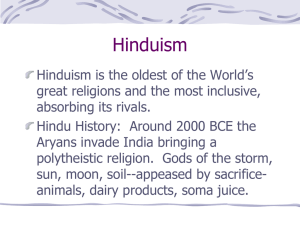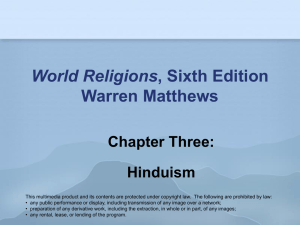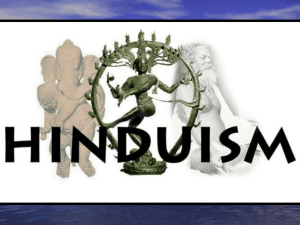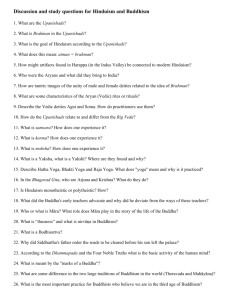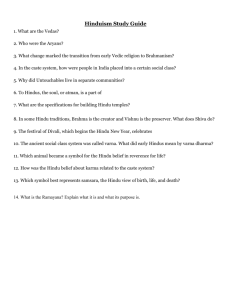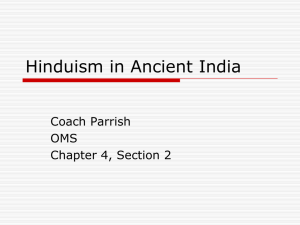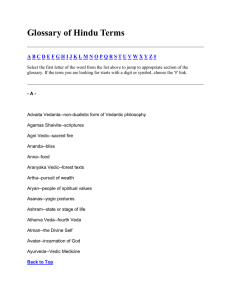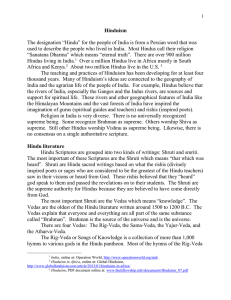Vocabulary for Hinduism
advertisement
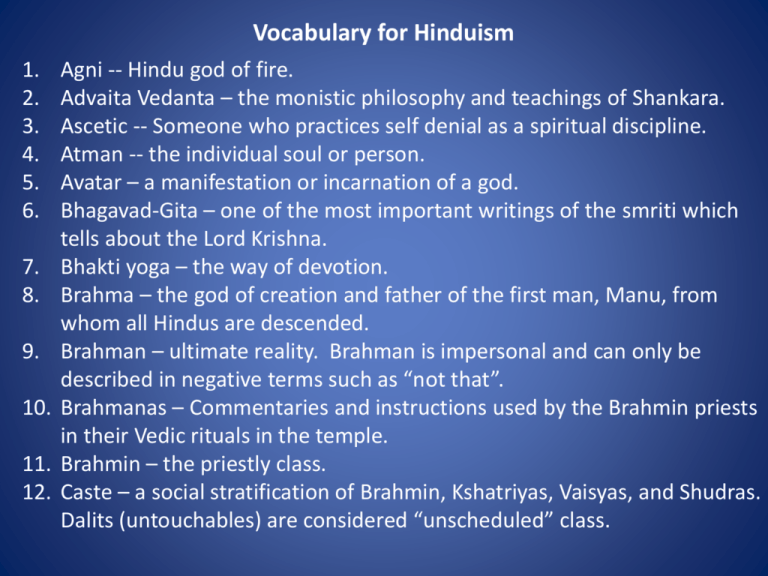
Vocabulary for Hinduism 1. 2. 3. 4. 5. 6. 7. 8. 9. 10. 11. 12. Agni -- Hindu god of fire. Advaita Vedanta – the monistic philosophy and teachings of Shankara. Ascetic -- Someone who practices self denial as a spiritual discipline. Atman -- the individual soul or person. Avatar – a manifestation or incarnation of a god. Bhagavad-Gita – one of the most important writings of the smriti which tells about the Lord Krishna. Bhakti yoga – the way of devotion. Brahma – the god of creation and father of the first man, Manu, from whom all Hindus are descended. Brahman – ultimate reality. Brahman is impersonal and can only be described in negative terms such as “not that”. Brahmanas – Commentaries and instructions used by the Brahmin priests in their Vedic rituals in the temple. Brahmin – the priestly class. Caste – a social stratification of Brahmin, Kshatriyas, Vaisyas, and Shudras. Dalits (untouchables) are considered “unscheduled” class. 13. Dharma -- cosmic law similar to the concept of fate in that this law determins all of life. 14. Ganesha -- Hindu god of success who removes obstacles. 15. Guru -- a Hindu spiritual advisor or teacher. 16. Jnana yoga – meditation and contemplation of wisdom and knowledge. 17. Kali -- goddess of time, doomsday, and death. Kali is the counterpart of Shiva the destroyer. They are the destroyers of unreality. The ego sees Mother Kali and trembles with fear because the ego sees in her its own eventual demise. 18. Kama-sutra – Hindu literature that gives practical advice on sexual intercourse. 19. Karma – the idea of cause and effect. Our actions have results and consequences. 20. Karma-yoga -- the path of right action. 21. Krishna – a manifestation of Vishnu. 22. Mantra – a sound, syllable, or word upon which someone meditates. 23. Maya – illusion. 24. Moksha – release from the endless cycle of reincarnation known as samsara. 25. Monism – belief in a unified universe. The universe is Brahman; it is nondualistic. 26. Om – the sound of the universe and the most popular mantra. 27. Puja – Hindu prayer ritual and worship of a god or goddess. 28. Raja yoga—the way of training the mind to free the soul. 29. Samsara – continual cycle of birth, death, rebirth and death. Reincarnation. 30. Sanatana Dharma -- "eternal dharma" or "eternal religion“ used by Hindus to describe their religion. 31. Sankhya—the belief that the universe is not only Brahman but rather a duality of two realities: Purusha (consciousness) and Prakriti (the natural world) 32. Shiva -- god of time. He is pictured as endlessly drumming worlds into existence but also burns up everything while showing no emotion. 33. Shruti – the most important Hindu Scripture made up of the Vedas and the Upanishands. 34. Tantrism – esoteric practices and rituals. 35. Upanishads -- the last of the Shruti are the Upanishads. Upanishads, also called “Vedanta (conclusion of the Vedas)”, literally means: “sitting devotedly near.” 36. Varnas -- Sanskrit word for “caste”. 37. Vedanta – Hindu philosophy in which the goal of life is to achieve a state of self-realization or cosmic consciousness 38. Vedas – Oldest of the Hindu Scriptures 39. Vishnu – One of the most important of the Hindu gods and is part of the triad of gods: Brahma the creator, Shiva the destroyer, and Vishnu the preserver. 40. Yantra -- visual shapes usually geometric and highly symmetrical that help a person to meditate. Some believe that the shapes are symbols of a god’s energy pattern. 41. Yoga – means “way” ; the four main types of yoga are jnana yoga—way of knowledge, karma yoga—the way of action, Bhakti yoga—the way of devotion, and raja yoga—the way of training the mind to free the soul.


